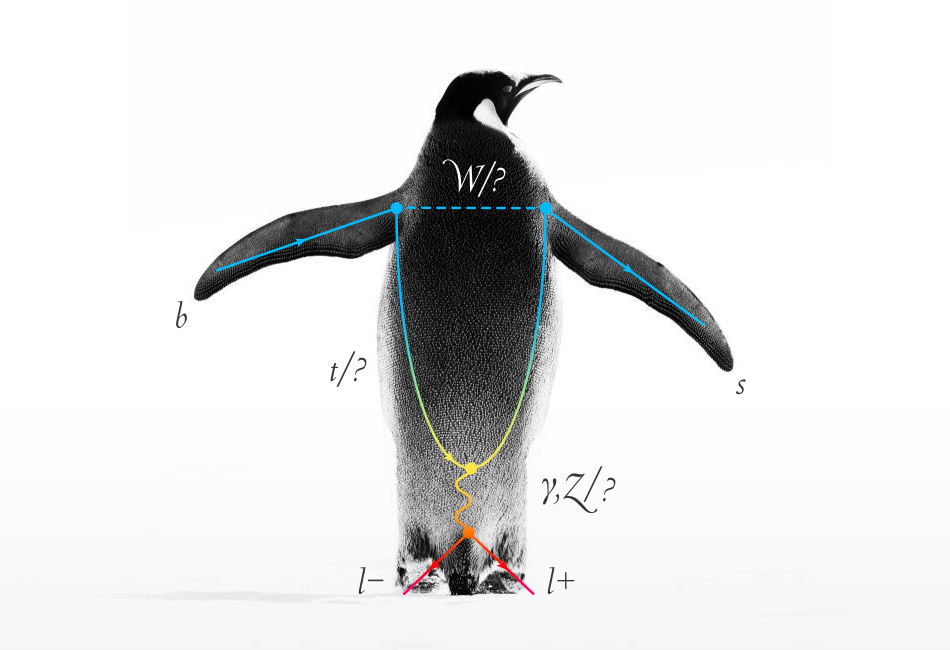‘Penguin’ Anomaly Hints at Missing Particles

A penguin-shaped anomaly first detected two years ago has survived a comprehensive new analysis of data from the first run of CERN’s Large Hadron Collider (LHC), scientists revealed today at a meeting in La Thuile, Italy.
The anomaly, an unexpected measurement of rare particle decays called “penguin processes,” isn’t statistically significant enough to constitute a discovery, but if the signal strengthens in the LHC’s upcoming second run, it will imply the existence of new elementary particles beyond those of the Standard Model — the precise but incomplete equations that have governed particle physics for 40 years.
“What we find is that this anomaly has persisted,” said Guy Wilkinson, a physicist at the University of Oxford and the spokesperson for the LHCb collaboration, which first detected the statistical bump in penguin decays in 2013. “This is extremely interesting.”
The finding comes as the LHC sputters back to life after a two-year upgrade that will nearly double its previous operating energy. The hopes of thousands of particle physicists are riding on the protons that in the coming years will collide there, shattering into petabytes of data that may carry long-awaited answers to fundamental questions about nature, and the penguin anomaly is one reason for optimism.
Most unexpected bumps in data go away as more data accumulate, just as you might get seven heads in your first 10 coin tosses only to end up with a 50-50 ratio after many more tosses. But after tripling their original sample size and analyzing approximately 2,400 of the rare penguin decays, the LHCb scientists say the anomaly hasn’t diminished. Instead, it has lingered at an estimated statistical significance of “3.7 sigma,” which means it is just as unlikely for such a large fluctuation to happen randomly as it would be to get 69 heads in 100 coin tosses. Physicists require a 5-sigma deviation from their expectations, equivalent to flipping 75 heads in 100 tosses (the odds of which are less than one in a million), to claim the discovery of a real effect.
“To really nail this, we will need additional data that we will collect in the coming run of the LHC” beginning in May, Wilkinson said.
With precious few other leads, the penguin anomaly has tantalized theorists since LHCb first reported it. Most of the matter in the universe — the particles that make up “dark matter” — is completely missing from the Standard Model, and what is included seems fragmentary and suggestive of a larger pattern. Physicists built the most powerful machine in history to search for signs of those more complete laws of nature. But almost everything about the way particles shape-shifted and shattered during the first round of collisions at the LHC precisely matched Standard Model predictions. In the 3.7-sigma penguin anomaly — as well as another, 2.6-sigma deviation the group detected in a different penguin process — some particle physicists see a sliver of hope that new discoveries lie around the corner.
“We’re chasing an imaginary ambulance,” said Sheldon Glashow, a Nobel Prize-winning theoretical physicist at Boston University, discussing the LHCb anomalies last week before he and most other experts had learned the results of the new analysis. “It could be very important, and also it could be nothing.”
Penguin decays were so named by the physicist John Ellis in 1977; when a loss at darts obliged him to use the word “penguin” in his next academic paper, he noticed that diagrams of the decays discussed in the paper happened to resemble the flightless birds. The decays are intriguing precisely because they are sensitive to the effects of unknown particles. During a penguin decay, one type of quark transforms into another, momentarily giving rise to ghostly virtual particles along the way. Before disappearing, the virtual particles — which may be photons, Z bosons or other, unknown participants that are not part of the Standard Model — might emit a lepton-antilepton pair. (A lepton is a particle category that includes electrons.) If some as-yet-undiscovered particle does play a ghostly role in penguin decays, it will spew leptons with unexpected combinations of energies and directions, skewing measurements. Sure enough, the LHCb scientists measured a 3.7-sigma discrepancy with the Standard Model in some outgoing particles’ combined energies and directions.
In the related 2.6-sigma anomaly, the scientists found that penguin processes produced more of some leptons than others, violating a Standard Model rule called “lepton universality.”
Researchers say the two anomalies have boosted each other’s perceived importance, because a single hypothetical particle could explain both. Candidates for this mystery participant in penguin processes have been proposed, including the hypothetical Z’ boson and the leptoquark. The two possibilities point to more complete frameworks for understanding quarks and leptons, which might explain why there are six “flavors” of each — information not provided in the Standard Model. “We don’t know what flavor is,” said Javier Virto, a theoretical particle physicist at the University of Siegen in Germany. “If we can find out whether the new physics is this or that, then probably we can try to figure out the answer.”
But models of Z’ bosons and leptoquarks struggle to work around the apparent nonparticipation of the particles in other, related decays, which show little evidence of deviations from the Standard Model. “There is no compelling framework in which all the data fits nicely,” said Adam Falkowski, a theoretical physicist at the Laboratory of Theoretical Physics in Orsay, France.
When the LHC resumes bashing particles together in May, LHCb scientists will continue tracking penguin decays in hopes that the anomalies in the data will climb to 5-sigma certainty, signifying an indirect discovery of “new physics.” Meanwhile, the two biggest scientific collaborations at the LHC, known as ATLAS and CMS, will search directly for the new particles that might be responsible for the penguin anomalies — if the anomalies are real.
The anomalies could go the way of so many others detected in high-energy experiments, including some measured by LHCb in recent years, and flatline as more data accumulates. “LHCb has broken my heart so many times,” said Nima Arkani-Hamed, a theoretical physicist at the Institute for Advanced Study in Princeton, N.J.
With no immediate plans for the construction of a larger, more powerful particle collider, and no hard 5-sigma data on which to build theories, particle physicists are desperate for something to show up during the LHC’s next run. Some are rooting for leptoquarks, while others hold out hope for particles predicted by a theory called “supersymmetry,” which could account for dark matter and help explain the masses of particles in the Standard Model. Still other experts expect to find cousins of the Higgs boson, the last missing particle of the Standard Model, which was discovered in 2012.
“I have this now-or-never feeling,” Falkowski said. “Personally, I’m counting most on additional Higgs-like [particles] to show up, but I will take anything that is offered.”
Correction on March 23, 2015: The original article misspelled “Siegen” as “Seigen.”
This article was reprinted on BusinessInsider.com.



